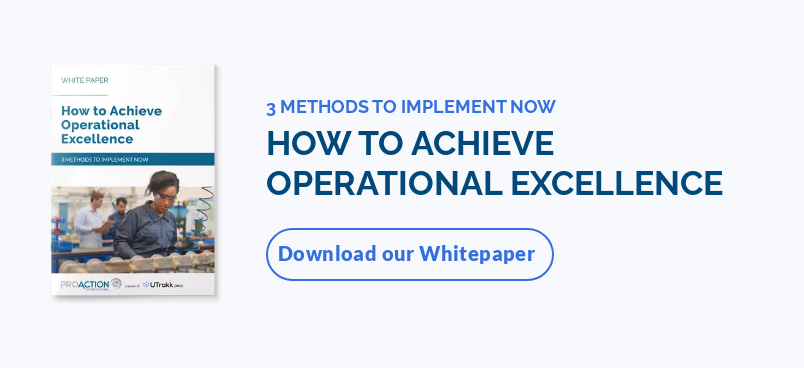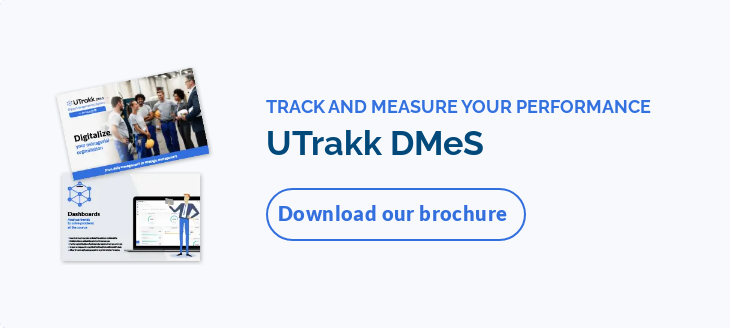5S methodology: The heart of the Lean Manufacturing philosophy
Originating from the Toyota production system, the 5S methodology is a Japanese technique included in Lean Management practices. It is used in offices and factories to manage and organize workstations.
This Lean approach is a cyclical methodology designed to eliminate waste from the manufacturing process, and improve operational efficiency and working conditions by creating a clean, organized and efficient workplace.
It includes five fundamental steps, each with their own objectives, that must be followed in a precise order:
Seiri – Sort
The 5S methodology starts with sorting and getting rid of anything useless in the workspace. Eliminating waste includes removing unnecessary items, excess inventory, unused equipment, and hazardous materials.
Seiton – Set in order
Once the initial sorting has been done, it’s time for workplace organization. Remaining items must be arranged in a logical and accessible way so that workers can quickly find what they need (frequently used tools can be stored on shadow boards or shelves for example).
Seiso – Shine
Following proper cleaning procedures for workstations and the production floor (including production equipment) is essential to maintaining an organized and safe environment. This includes not only surface cleaning, but also the identification and removal of potential sources of pollution.
Seiketsu – Standardize
To ensure the sustainability and correct application of the first three "S’s", it is essential to establish standards and procedures to enforce these new practices. This fourth step in the 5S methodology fosters a culture of efficiency and continuous improvement, and helps maintain cleanliness.
Shitsuke – Sustain
This is the final step of the 5S methodology. It focuses on user discipline and the consistent enforcement of the rules in place in the organizational system. It's about maintaining previous efforts to ensure that the method is effective over the long term, that it becomes an integral part of the organization’s culture.
The benefits of the 5S methodology for the manufacturing industry
Especially used in manufacturing facilities where efficiency, quality and safety are essential, the 5S methodology offers many benefits:
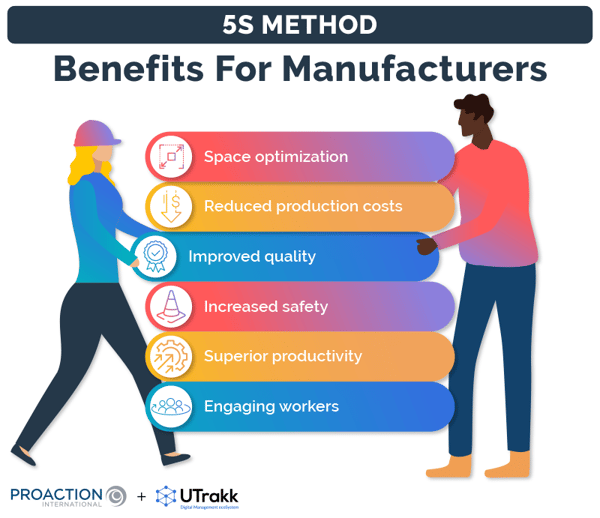
Space optimization
By eliminating clutter and organizing resources efficiently, the 5S methodology maximizes the use of available space. This is important in factories where every square meter counts.
Reduced production costs
One of the main goals of the 5S methodology is to reduce waste. And by eliminating waste, this method contributes to reducing production costs, leading to increasing profitability.
Improved quality
A clean, organized work area reduces the risk of manufacturing errors and defects. The standards set by the 5S methodology help to maintain high levels of quality.
Increased safety
A well-organized, clutter-free environment reduces workplace hazards and injuries. In addition, 5S encourages preventive maintenance, which contributes to employee safety.
Superior productivity
By reducing waste, obstacles, equipment failure, and wasted time, and by improving quality, the 5S method greatly enhances productivity, leading to a positive impact on the company's overall efficiency.
Engaging workers
The 5S methodology creates a framework that fosters staff engagement by encouraging them to actively participate in building a productive workspace. It gives them a sense of control, responsibility and pride, while improving the quality of their daily environment. As a result, teams are more engaged, creative and efficient.
Visual communication in the 5S methodology
Visual communication is an essential element of the 5S method. It relies on the use of visual tools to clearly and concisely convey information about organization, standardization and safety, creating a visual workplace where everyone can work with greater efficiency.
Here are some of the visual control tools commonly used in 5S:
- Labels on objects, shelves, cabinets, and equipment indicate their location, use and status.
- Tables that indicate storage locations for tools, parts and equipment.
- Floor marking tape delineates work areas, storage spaces, circulation paths, and specific equipment locations.
- Signs provide instructions, procedures, safety hazards and guidelines, process diagrams, etc.
- Visual displays (graphics, images and pictograms) illustrate standards or instructions.
How does the UTrakk Daily Management System reinforce and sustain the 5S methodology?
A daily management system (DMS) is a set of work practices, work processes and tools used by an organization to monitor, manage and improve day-to-day activities.
Manufacturers use this software to maintain a consistently high level of performance throughout the organization, with a focus on the proactive management of problems and opportunities.
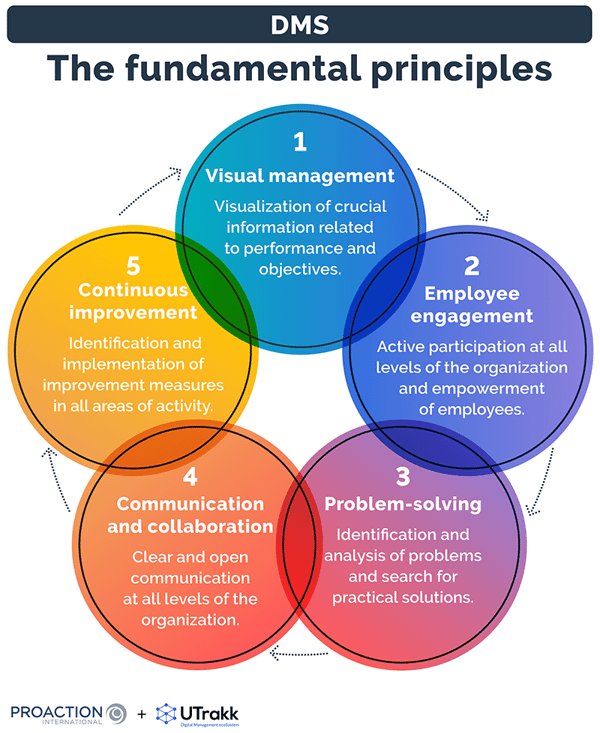
Designed for both Industry 4.0 and Industry 5.0, UTrakk is a daily management system that guides the frontline manager through each of their daily operations, while providing an overview of priorities, activities, actions, as well as management and performance data.
By connecting and aligning all hierarchical levels of an organization within a single platform, this helpful tool facilitates decision-making and communication between these levels, offering a global vision and unified management.
UTrakk offers many useful features designed for the manufacturing sector, ensuring that the 5S methodology is adequately implemented and sustained:
Features for implementing the 5S methodology
Real-time tracking
UTrakk DMS offers constant monitoring of daily activities, including 5S compliance. It ensures that 5S standards are maintained over time, preventing any slow down after the initial implementation.
The Rituals module enables planning of daily tours during which key parameters of the implemented standards are monitored. The workstations targeted by these audit tours can have their own checklists, customized to meet unique companies’ needs. Expected results, including compliance thresholds, are configured in each checklist, enabling supervisors to quickly identify variances.
To fully understand what is expected at a specific workstation, photos can also be added to the checklist. This UTrakk feature not only identifies any variance at a glance, but also documents non-conformities with a descriptive text, a "cause of variance" that has been pre-configured in the DMS, or attached photos.
When the tour is completed, the DMS issues a summary of the discrepancies raised and actions taken, facilitating close follow-ups leading to rapid resolutions.
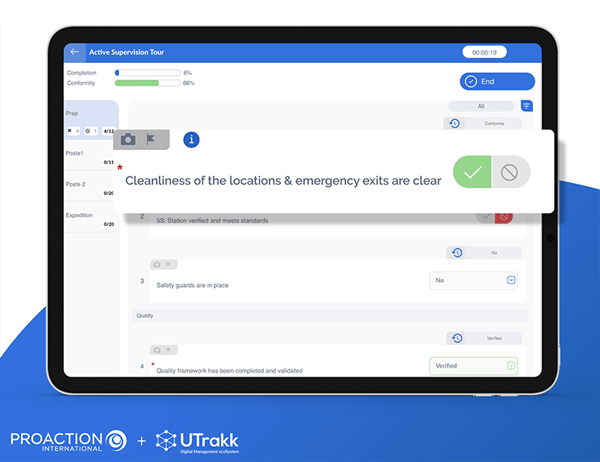
Daily meetings
Daily meetings in the UTrakk Rituals module provide an ideal framework for sharing information on progress and any problems associated with 5S. Field teams can share results, discuss challenges, issues and gaps, and plan immediate corrective actions if necessary.
An undeniable strength of the UTrakk system is the option of sending an action in real time to the person in charge of resolving the discrepancies raised. This action can be added to another ritual (production review, continuous improvement meeting, or health and safety committee), directly from the tour window on the application.
UTrakk's ability to bring actions to the management teams, where decisions can be made quickly with the right people, enables tremendous time and efficiency gains.
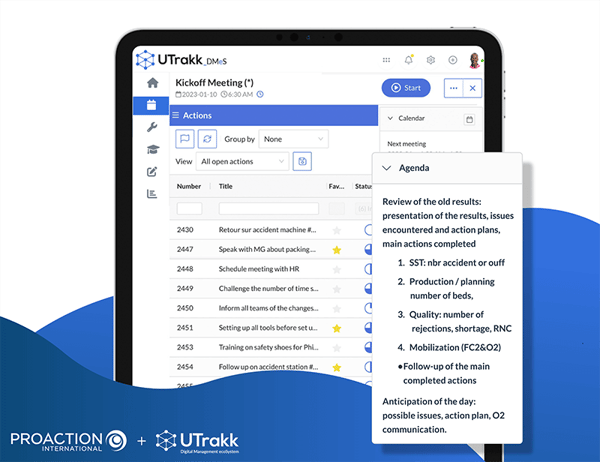
Key performance indicators (KPIs)
Lean Manufacturing KPIs can be defined to monitor compliance with the 5S methodology. This enables results to be measured and performance to be assessed against clearly defined, data-driven objectives.
The UTrakk DMS Dashboard module enables users to define performance indicators and record data at a predefined frequency. Results are displayed in graphics, making it easy to monitor progress and take corrective actions if necessary.
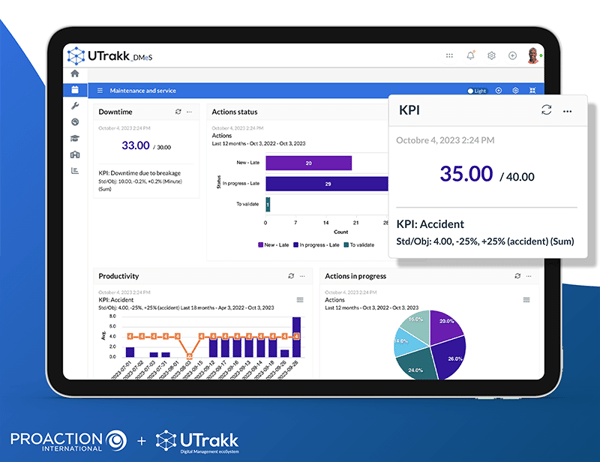
Planning and monitoring improvement actions
When 5S improvement opportunities are identified, UTrakk enables systematic planning, monitoring and prioritization of the actions that need to be taken. This ensures that changes are effectively implemented.
Depending on the scope of the improvement to implement, a few functionalities are available to ensure adequate follow-up:
- An Action: A simple option requiring one responsible person and a deadline set in the near future.
- An Opportunity: The go-to feature if the parameters of the improvement are unclear – no responsible person is identified, the deadline is not set, and the actions to be carried out are not defined.
- A Project: If the improvement is a large-scale undertaking, requires input from several departments, and needs to be rigorously monitored, the Project Tracking function is the one to use.
All these features can be associated with a Meeting in the UTrakk system, to ensure timely monitoring, decision-making process, and completion of improvement actions. Depending on how the improvement evolves, the DMS can move an Action to an Opportunity, and an Opportunity to a Project, all while keeping the associated data.

Process standardization
UTrakk promotes the standardization of manufacturing processes and management routines (such as the Leader Standard Work), in compliance with the fourth "S" (Seiketsu – Standardize) of the 5S methodology. This helps to maintain consistent practices and guarantees that 5S standards are met.
The DMS offers a Knowledge Center in which the implemented standards and practices can be documented as “Procedures”. A Procedure can include text, photos, videos, and links, reducing any risks of confusion, misunderstanding, or non-compliance with standards.
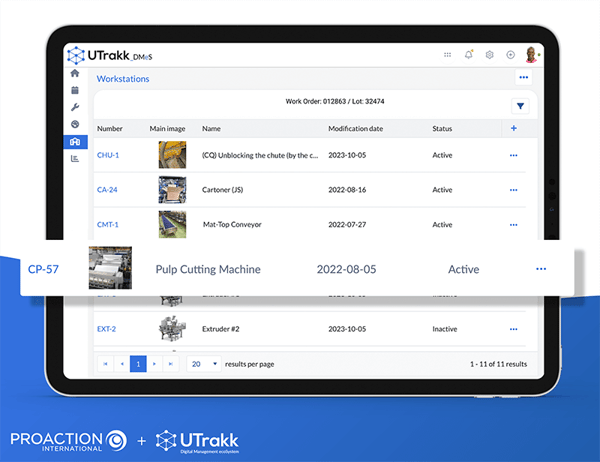
The benefits of the UTrakk DMS, combined with the 5S methodology
Continuous improvement culture
By combining the daily management system with 5S, organizations promote a culture of continuous improvement in which operational efficiency, quality and safety are continually enhanced.
The use of a DMS ensures that 5S principles are not simply implemented once, but rather maintained and optimized on an ongoing basis, maximizing the benefits of the 5S method.
Employee involvement
The DMS encourages the participation of employees from all organizational levels. This fosters commitment to maintaining 5S standards as employees play an active role and are more accountable.
Clear communication and transparency
The Utrakk DMS encourages visual management. It allows standards, procedures and locations to be displayed in one place. This makes information more accessible and understandable at a glance for every team member, regardless of their language skills.
What's more, the DMS enhances transparency in terms of performance and accountability. When 5S principles are standardized and known, it's easier to track and communicate each team member's responsibilities.
Synergy between 5S and DMS: The path to sustainable performance
Implementing the 5S in manufacturing offers significant benefits in terms of efficiency, quality and safety. However, to maximize these benefits and maintain established standards, the use of a daily management system such as UTrakk is highly recommended.
Together, these two approaches help to create an optimized work environment that is sustainably efficient and set for continuous improvement.





